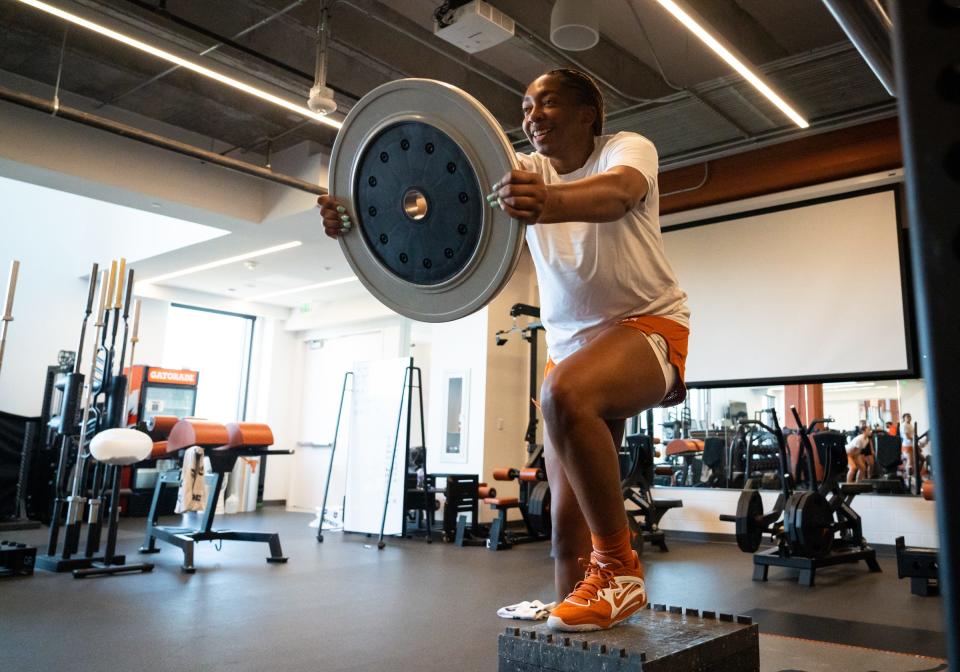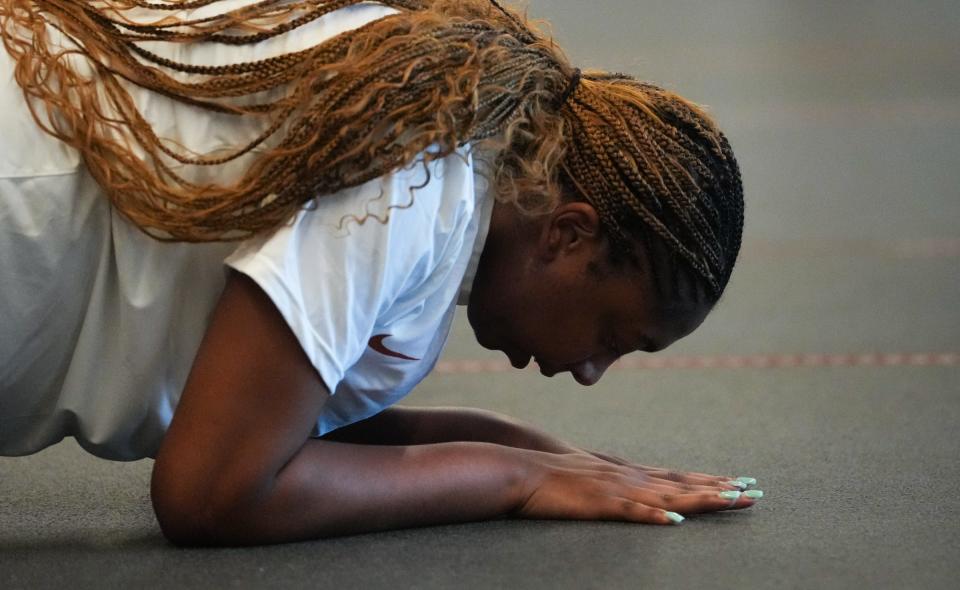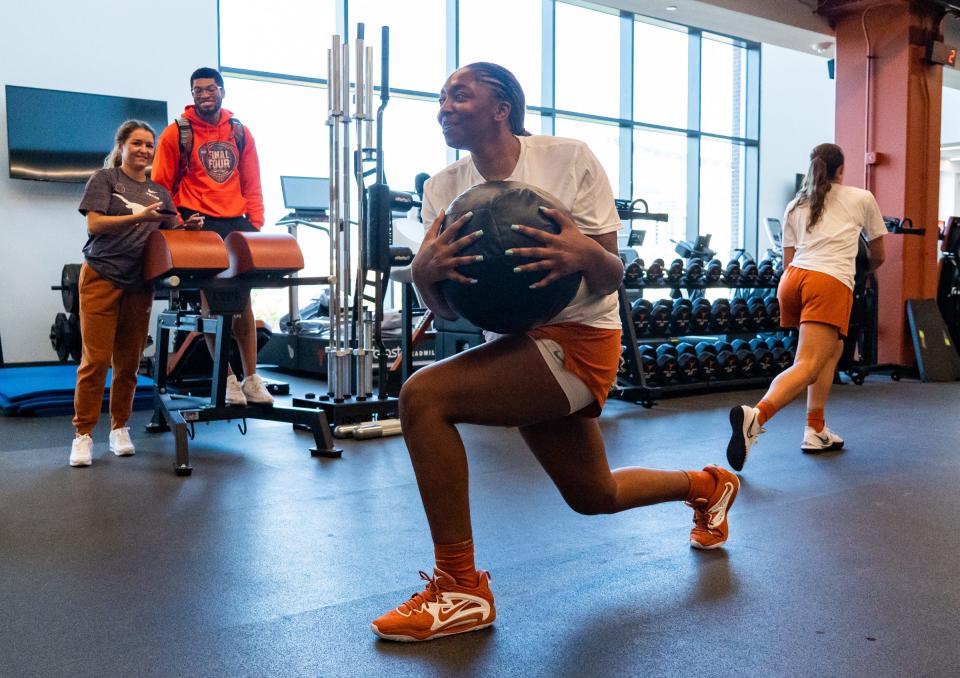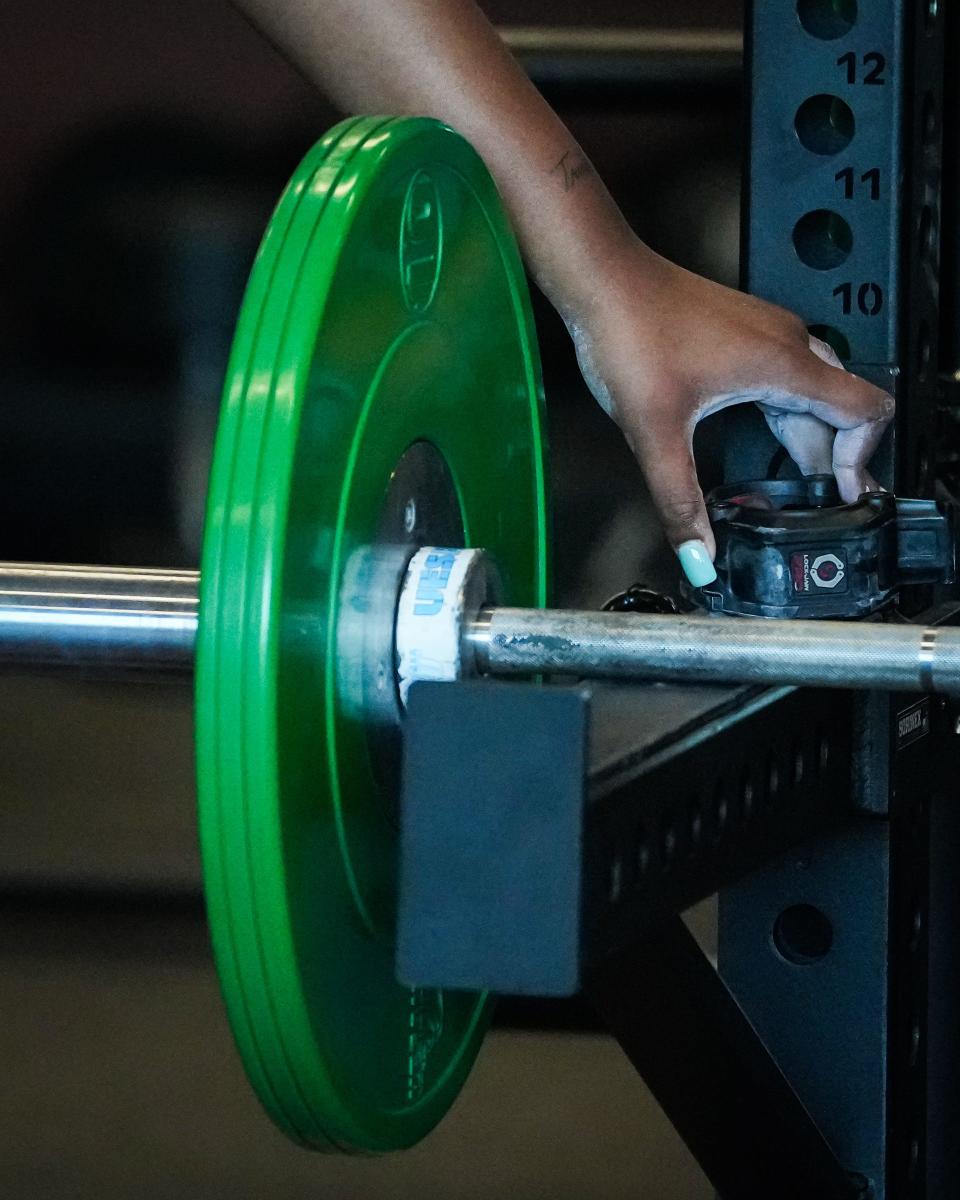Heart of an athlete: UT basketball player recovers physically, mentally from heart surgery
- Oops!Something went wrong.Please try again later.
- Oops!Something went wrong.Please try again later.
University of Texas basketball center Tionna Herron is in the weight room daily at UT's workout facility. She's lifting dumbbells, using weight machines and putting her body weight to work to strengthen her muscles, including her heart.
She also hits the court during practice, but unlike her teammates, Herron, 20, uses a heart rate monitor. Her coaches are closely watching her after Herron had to take a year off the court to have her heart repaired.
The redshirt freshman from DeSoto, near Dallas, discovered she had anomalous aortic origin of a coronary artery, a congenital heart defect. In her case, her right coronary artery was coming from the left side instead of from the right aortic sinus.
If Herron's heart defect had not been discovered and fixed, she could have been one of the student-athletes people see collapse during a game.

Fixing Herron's heart
Doctors at Texas Children's Hospital in Houston were able to detach her right coronary artery from its origin and reattach it to the correct place.
"Now the artery is arising as it should be," said Dr. Silvana Molossi, a cardiologist with Texas Children's and Herron's doctor.
The Holy Grail question about a defect like Herron's is what will cause a sudden cardiac arrest, Molossi said. She asks: Why is a kid with a coronary artery anomaly able to exercise every single time and sometimes even more strenuously and not have anything happen, and then that one time collapse on the field or court?
One guess is that the risk increases with age because these events often happen between 10 and 30 years old. It also could be related to puberty, Molossi said.

Understanding the warning signs
Herron came to UT after a year at the University of Kentucky in which she did not play because she was recovering from the surgery.
Herron had a life of what she called "chest cramps." The first time it happened to her, she was 8 and on the basketball court. Doctors told her parents she was born with a mitral valve prolapse and she could take ibuprofen when she had those chest cramps.
The cramps went away, and Herron got more invested in basketball. Her senior year of high school, though, the cramps came back. During an unrelated surgery, the anesthesiologist and surgeon noticed she had an irregular heart rate.
Herron had an MRI and did a stress test. Doctors in Dallas diagnosed her with the anomaly and concluded that her heart condition wasn't serious and that she didn't need surgery.
She didn't have complaints and had no dizziness. She didn't pass out but occasionally she would get that chest pain, though it wasn't consistent.
Helplessness on the field: An 11-year-old Austin soccer player's heart stopped for 22 minutes. Doctors explain why.
When she arrived at the University of Kentucky, though, the program there did testing and sent her to Emory University Hospital in Atlanta. There doctors discovered her heart wasn't pumping enough blood for her to be able to play college basketball. She had only 68% oxygen in her blood, instead of the normal above 90%. She would need surgery.
Herron didn't want to be so far away from home. Her mom found doctors at Texas Children's in Houston, and Herron decided to come home to Texas and have the surgery to fix her heart on Aug. 24, 2022.
"The recovery part was hard," said her mother, Angel Worlds. It took Herron awhile to be able to do anything other than walk. Once she could start doing some workouts, "I did notice that she stopped complaining about her chest hurting during workouts," Worlds said.
Predicting heart problems
Molossi and Herron's other doctors believe they have fixed her heart problem and that she's safe to participate fully in sports. There's only about 20 years' worth of data on repairs to these anomalies, Molossi said. Doctors will never say for certain that Herron won't have future heart problems, but they don't anticipate any, she said.
Athletic heart screenings using an electrocardiogram can find some heart defects but not necessarily this one, Molossi said. It would show up on a heart ultrasound. There have been debates among the medical community about which heart screenings should be done on young athletes, but no official recommendations.
There seems to be a genetic link to sudden cardiac arrest in some families, though no gene has been identified yet, Molossi said. Families with a member who has had an anomaly or a sudden cardiac arrest should consider doing a screening, Molossi said. That screening would provide helpful information for those families, she said.

Becoming a Longhorn
Herron arrived at UT this summer after women's basketball head coach Vic Schaefer learned that she was available. He respected her high school program at DeSoto, which had won state championships.
"She was a pretty high-profile high school player," he said.
To recruit Herron, Schaefer said, "we did our homework and got all the medical records we needed."
Since she arrived in Austin, she has been going through conditioning with her teammates.
"It's hard, but I'm getting through it," Herron said.
The mental part, reminding herself that she had heart surgery and should not expect herself to be at the same level as she previously was, is hard, she said.
"It was hard not playing basketball for a whole school year and then going a year and a half without playing basketball," she said. "I didn't have an outlet."
Heart prevention: After cardiac arrest of LeBron James' son, what do Austin student athletes need to know?
Returning to the court
Schaefer doesn't know yet whether Herron will be ready to play in a game this year. The Texas women's team is expected to win the Big 12 and be in the top 20 in the nation, Schaefer said. He is hoping to get her physically and mentally ready, if not for this year, then for next year.
"She's been cleared multiple times from her doctor," Schaefer said. "From a heart standpoint, we've been told she's more than ready to go."
A heart injury is a challenge that's different from a limb injury such as a torn knee ligament, said Zack Zillner, the sports performance coach for women's basketball at UT. With a torn anterior cruciate ligament, "everyone can see that," he said. About the heart, he said, "You don't realize the trauma of the injury."
Schaefer also agrees that it's a mental exercise now. Because this is her heart, anytime she has discomfort in her chest, "there's concern," Schaefer said. "That's to be expected. She's had open heart surgery. That's a pretty signficant thing to have done to you."
Part of the training is building up not only Herron's endurance, but also her confidence. Zillner is showing her numbers and data to prove her heart can handle the workout.
"Mentally, she's handling it a lot better than I would have, for sure," Zillner said.
The coaches also take her to be evaluated by cardiac doctors at UT's Dell Medical School to continue to show her what her heart is capable of doing, but it will take time, Zillner said.
"This is a process," he said.
She will also be able to follow up with Texas Children's cardiac doctors in Austin. Texas Children's will open a hospital in Austin Feb. 1, but already has specialists working in Austin.
Herron is now in the workout room two to three hours a day but doing low-intensity workouts. She is also at practice. She is getting up to speed, Zillner said.
Herron is given more recovery time between cardio exercises, and she knows by her heart rate monitor when she needs to back off. She needs less and less time between exercises, he said.
They will take their time with her, Zillner said, because she's had a year off.
"We are asking a sedentary individual to do what the top 1% of athletes can do," Zillner said of the training.
Herron knows that after the season starts Nov. 8, it will be a while before she plays in a game, but "I believe they have the resources to get me to where I want to be," she said. "That's my main focus right now."

Know these warning signs
Student-athletes should tell a doctor if they feel:
Chest pain
A sensation of the heart racing or fluttering
They should tell doctors if they have a family history of:
Cardiac arrest
A person needing a defibrillator, especially at a young age
This article originally appeared on Austin American-Statesman: Texas Longhorns basketball's Tionna Herron returns from heart surgery

